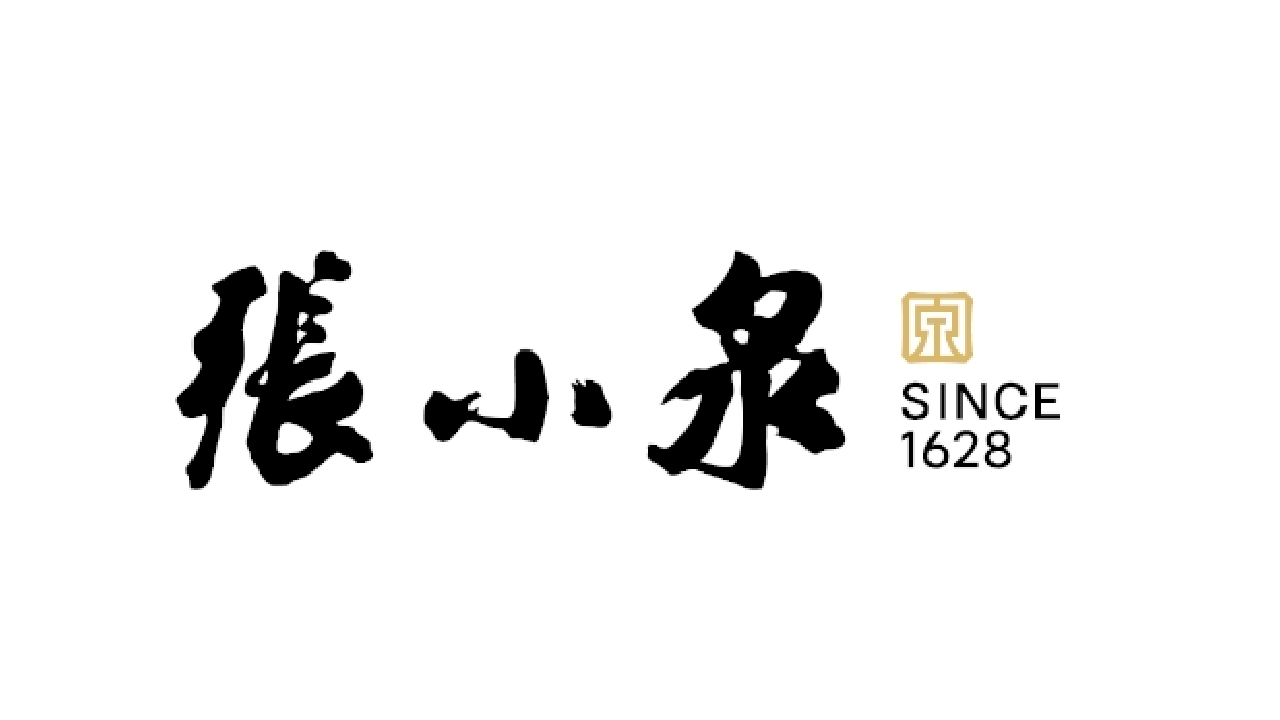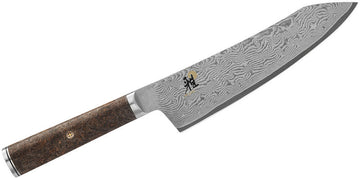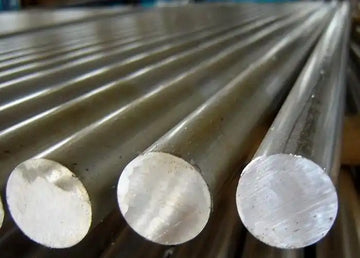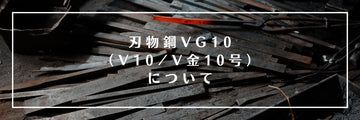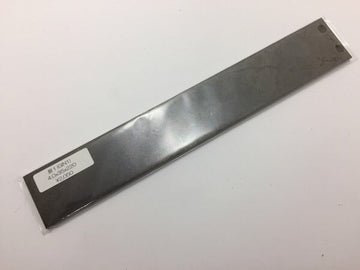There was an old knife maker in the small village where my grandfather lived. His hands, rough as tree bark, could tell the steel quality just by touching it. "Good steel," he would say, "is like a faithful friend. It stays sharp when you need it, doesn't rust when you forget it, and forgives you when you drop it." Today, I want to tell you about such a friend: 10Cr15CoMoV steel, a remarkable material that has become the pride of Chinese knife making.
What Makes 10Cr15CoMoV Kitchen Knife Steel Special?
This steel with a complicated name is actually quite simple in its purpose. 10Cr15CoMoV is China's answer to Japan's famous VG-10, created to make knives that stay sharp, resist rust, and survive the daily battles of a busy kitchen.
| Chemical Element | 10Cr15CoMoV (%) | VG-10 (%) | Element Function |
|---|---|---|---|
| Carbon (C) | 1.05 | 1.00 | Increases hardness, edge retention, and wear resistance. Critical for forming hard carbides. |
| Chromium (Cr) | 15.50 | 15.00 | Provides stainless properties and corrosion resistance. Forms protective oxide layer and contributes to steel hardness. |
| Cobalt (Co) | 1.50 | 1.50 | Improves heat treatability, and thermal stability, and increases strength at high temperatures. |
| Molybdenum (Mo) | 1.20 | 1.00 | Enhances hardenability, machinability, and pitting resistance. Helps steel harden during manufacturing. |
| Vanadium (V) | 0.30 | 0.25 | Refines grain structure and increases toughness and wear resistance. Forms hard carbides that improve edge retention. |
The name might sound like a secret code, but it actually tells us what's inside. The "10" means it contains about 1% carbon – the element that makes steel hard and able to hold a sharp edge. "Cr15" reveals there's 15% chromium, which fights against rust. The "Co" points to cobalt, a special ingredient that few knife steels contain, and "Mo" and "V" stand for molybdenum and vanadium, which strengthen the steel in different ways.
Think of these elements as family members living in one house. Carbon is the stern grandfather who insists on discipline and hardness. Chromium is the protective mother who keeps everything clean and rust-free. Cobalt is the wise uncle who brings stability when things get hot. Molybdenum and vanadium are the hardworking children who add strength and sharpness to the family.
10Cr15CoMoV Steel Hardness and Edge Performance
After the steel is properly heated and cooled (what knife makers call "heat treatment"), 10Cr15CoMoV reaches a hardness of 58-63 HRC. This number might not mean much to you, but imagine the difference between cutting a tomato with a sharp knife and a dull one. A knife made from this steel stays in the "perfect tomato slicer" category much longer than ordinary knives.

The high hardness allows the edge to be very thin – about 15-18 degrees on each side. This is like the difference between trying to push a wide wooden block through water versus a thin sheet of paper. The thin edge of these knives slices through food with much less resistance, making your cutting work easier and more precise.
What makes 10Cr15CoMoV kitchen knives special is that despite being very hard, they're not overly brittle. The cobalt in the steel is like the peacekeeper in a village dispute – it prevents small conflicts (microscopic cracks) from becoming big problems (a broken knife). This means even thin edges can withstand some sideways pressure without chipping.
10Cr15CoMoV Corrosion Resistance: Fighting the Never-ending Battle Against Rust
Anyone who has left a knife wet overnight knows the orange surprise of rust that awaits in the morning. With more than 14% chromium, 10Cr15CoMoV steel creates an invisible shield against this enemy. Laboratory tests show it barely develops any rust spots even after soaking in salt water for three days – a remarkable achievement for any knife steel.

This corrosion resistance is particularly valuable when cutting acidic foods like tomatoes, citrus fruits, or vinegar-marinated meats. While less expensive steels might show staining or pitting after regular exposure to these ingredients, 10Cr15CoMoV stands firm against them, maintaining both its appearance and performance.
10Cr15CoMoV Knife Durability: Strength That Lasts
Strength in a knife isn't just about hardness – it's also about toughness, the ability to absorb impact without breaking. Thanks to cobalt's special role in stabilizing the steel's internal structure, 10Cr15CoMoV achieves an exceptional balance between hardness and toughness. When tested for impact resistance, it shows 25-30 J/cm² of fracture energy, significantly higher than many similar steels without cobalt.
This is like the difference between a martial artist who is both strong and flexible versus one who is merely strong. The combination allows these knives to handle not just delicate slicing but also tougher tasks like breaking down poultry or cutting through squash without fear of the edge chipping.
10Cr15CoMoV Chinese Cleaver: Versatility in the Kitchen
The balanced properties of 10Cr15CoMoV make it excellent for various types of kitchen knives:
Multi-purpose Kitchen Knife Made with 10Cr15CoMoV
In kitchen knives, this steel truly shines. Its edge stability supports the rhythmic chopping and rocking motions used for mincing herbs or dicing onions. The corrosion resistance handles the acidity of tomatoes and citrus without complaint. A 10Cr15CoMoV Meat Cleaver becomes a reliable partner that doesn't lose its sharpness halfway through meal preparation.

10Cr15CoMoV Fillet and Boning Knives for Precision Work
For the delicate task of filleting fish or deboning chicken, 10Cr15CoMoV offers the perfect combination of flexibility and edge retention. Where lower-quality steels would quickly dull against skin and bones, these knives maintain their precision, allowing clean cuts without waste. The high stain resistance is particularly valuable when working with fish, as the scales and slime can be quite corrosive to lesser steels.
Heavy-Duty Chinese Cleavers with 10Cr15CoMoV Steel
Perhaps surprisingly, this steel also performs admirably in cleavers and heavier blades. Despite its hardness, the cobalt-enhanced toughness allows it to handle impact-intensive tasks without edge damage. Industrial cleavers made from 10Cr15CoMoV show minimal edge deformation even when processing chicken bones or pork ribs, outperforming many traditional cleaver materials.
How 10Cr15CoMoV Steel Is Heat Treated
The transformation of raw 10Cr15CoMoV steel into a fine knife is something like turning wheat into bread – it requires precise temperatures and timing. Knife makers heat the steel to around 1,050-1,100°C, hot enough to make it glow orange-red and reorganize its internal structure. Then they quickly cool it in oil, freezing this new structure in place.

But this quick cooling makes the steel very hard yet brittle, like bread baked too long. To restore some toughness while keeping most of the hardness, they reheat it to a lower temperature (200-250°C) twice – a process called tempering. After this careful heat treatment, the steel contains uniformly distributed tiny particles of extreme hardness within a tough matrix – the perfect combination for a lasting edge.
10Cr15CoMoV vs. VG-10: Comparing Premier Knife Steels
Many people wonder how 10Cr15CoMoV compares to Japan's famous VG-10 steel. The truth is they're very similar, with 10Cr15CoMoV containing slightly more cobalt (1.8% vs. 1.5%). This gives the Chinese steel slightly better stability during the forging process.
In cutting tests, both steels can slice through sisal rope 800-1,000 times before becoming dull – an impressive performance far beyond what most kitchen tasks would ever demand. However, 10Cr15CoMoV shows better resistance to staining, thanks to a more even distribution of chromium throughout the steel.

10Cr15CoMoV vs. 5Cr15MoV: Premium vs. Budget Chinese Steel
For those looking at Chinese knives, it's worth understanding the difference between 10Cr15CoMoV and the more common 50Cr15MoV steel. The "5" in 50Cr15MoV indicates it contains only about 0.5% carbon – half as much as 10Cr15CoMoV. This results in lower hardness (54-56 HRC) and significantly reduced edge retention.
In tomato slicing tests, 50Cr15MoV edges typically dull after 200-300 cuts, while 10Cr15CoMoV continues performing well beyond 600 cuts. However, 50Cr15MoV's lower hardness makes it more forgiving for beginners and easier to sharpen with basic tools, making it a reasonable choice for casual cooks on a budget.
Caring for Your 10Cr15CoMoV Kitchen Knife
Even the finest steel requires proper care. Due to its high carbide content (those extremely hard particles formed by carbon combining with other elements), 10Cr15CoMoV is best sharpened with diamond or cubic boron nitride (CBN) stones. A 1,200-grit finish achieves the ideal balance between sharpness and microscopic "teeth" that enhance cutting performance.
While naturally resistant to staining, these knives still benefit from prompt cleaning and drying after use. Harsh detergents can eventually degrade the protective chromium oxide layer, so washing with mild soap followed by immediate drying is recommended. With this simple maintenance, a 10Cr15CoMoV knife can serve faithfully for decades.

The Value of 10Cr15CoMoV Steel Knives in Your Kitchen
10Cr15CoMoV represents one of China's finest contributions to kitchen cutlery, offering professional-grade performance at prices below comparable Japanese or Western options. Its thoughtfully balanced composition addresses the traditional trade-offs between hardness, toughness, and corrosion resistance, creating versatile knives suitable for everything from delicate slicing to robust chopping.
For both home cooks seeking an upgrade from basic cutlery and culinary professionals demanding reliable performance, knives made from 10Cr15CoMoV steel offer exceptional value. They deliver the enduring sharpness, stain resistance, and reliability that make cooking more pleasurable and efficient.
Like my grandfather's knife maker friend used to say, "The best knife is not the one that never gets dull, but the one that performs beautifully for years before needing attention, and then responds well when that attention is finally given." In 10Cr15CoMoV, this wisdom has found its modern expression.
FAQs
What is 10Cr15CoMoV?
10Cr15CoMoV is a premium Chinese stainless steel used in high-performance kitchen knives, containing 1.05% carbon, 15.5% chromium, 1.5% cobalt, 1.2% molybdenum, and 0.3% vanadium.
Is 10Cr15CoMoV good steel?
Yes, it's excellent steel for kitchen knives, offering superior hardness (58-63 HRC), exceptional edge retention, good corrosion resistance, and balanced toughness for both precision cutting and heavier tasks.
How does 10Cr15CoMoV compare to VG10?
They're very similar in composition and performance. 10Cr15CoMoV has slightly more chromium (15.5% vs 15%) and molybdenum (1.2% vs 1.0%), giving it marginally better corrosion resistance, while maintaining equivalent hardness and edge retention.
What are 10Cr15CoMoV steel properties?
Key properties include high hardness (58-63 HRC), excellent edge retention, good corrosion resistance, impressive fracture toughness (25-30 J/cm²), and balanced performance suitable for various kitchen knife applications.
Is 10Cr15CoMoV stainless steel?
Yes, with 15.5% chromium content (above the 13% minimum threshold for stainless classification), it forms a protective chromium oxide layer that provides excellent resistance to corrosion and staining.
Where is 10Cr15CoMoV steel made?
10Cr15CoMoV is manufactured in China as their premium knife steel, developed as a counterpart to Japan's VG-10 stainless steel.
How to care for 10Cr15CoMoV steel knives?
Wash with mild soap and dry immediately after use. Use diamond or CBN stones for sharpening. Avoid harsh detergents that can degrade the protective chromium oxide layer. Apply occasional food-grade mineral oil for optimal protection.
Is 10Cr15CoMoV better than 14C28N?
10Cr15CoMoV has higher carbon content and contains cobalt, giving it better edge retention and hardness than 14C28N. However, 14C28N offers slightly better toughness and is easier to sharpen, making it more forgiving for beginners.
What is the hardness of 10Cr15CoMoV steel?
After proper heat treatment, 10Cr15CoMoV reaches a Rockwell hardness of 58-63 HRC, placing it among premium high-hardness knife steels suitable for professional use.
What knives use 10Cr15CoMoV steel?
High-end Chinese kitchen knives use this steel, particularly chef's knives, fillet knives, boning knives, cleavers, and specialty slicing knives that require exceptional edge retention and performance.
